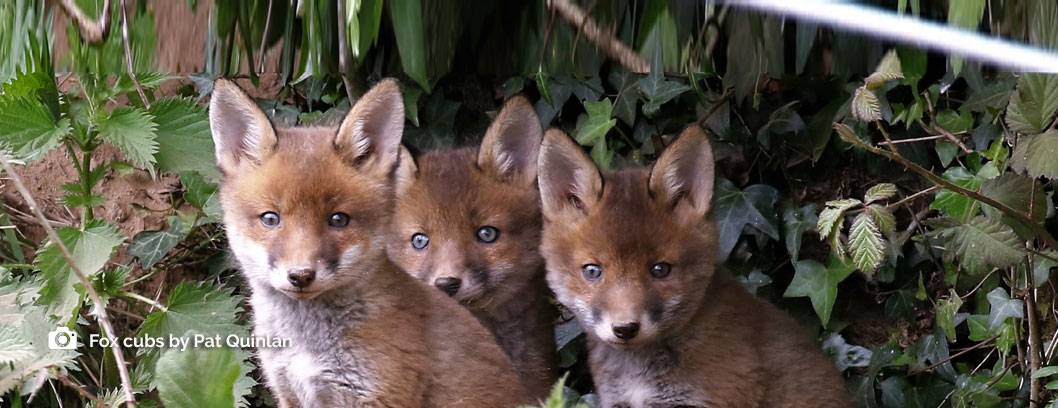
Position
The Irish Wildlife Trust does not encourage or condone the feeding of wild foxes.
Our native fox is a wild creature and should be treated as such. However, the following will
provide advice on how to feed foxes in the garden and other urban areas, providing some benefit
to the fox.
Red Fox
Vulpes vulpes
The Red Fox is common throughout Ireland, and is a versatile species, adapting to many habitats.
Description
Maybe our most recognizable species, resembling a small dog. Reddish coat, white chest with a distinctive bushy tail.
Diet
Foxes are omnivores, hunting small mammals and birds, insects and carrion. They also eat fruit such as apples and blackberries as well as seeds and nuts. They also scavenge and are known to raid bins in urban areas. While they have close family units, they are solitary hunters.
Reproduction
Mating occurs between December to February. Cubs are born between March and April. Up to 14 cubs can be born, but usually 4-6 is normal. Cubs spend the first month in their den. During this time the mother stays with the cubs, while the male provides food. After a month the cubs venture out of the den, though never to far. It is not unusual for the vixen to move cubs to a new den. Around October or November the cubs are largely independent, though may remain in a family group.
Conservation
Once hunted for its fur it is now hunted for recreation and predator control. It is not a protected species in Ireland.
Foxes are a very versatile and adaptable species.
These factors have enabled foxes to adapt to urban environments extremely well.
While generally shy and preferring to keep a distance from people, they have been able to successfully live alongside us.
Feeding foxes can be a contentious issue, and there are both positive and negative effects.
The following guidelines should help you feed foxes responsibly:
Dont’s
–> Feed close to houses – They may become too familiar with houses, associating all houses with food.
–> Never-ever hand feed – This can lead to problems with foxes becoming too familiar with people, leading to unwanted attraction.
–> Do not overfeed – Leftover food can attract pests like rats. Also overfeeding can cause foxes to reduce their natural territory range,
becoming reliant on one source of food. Foxes can also cache uneaten food, in your garden, or your neighbour’s!
Do’s
–> Replicate their natural diet with plenty of protein rich food such as cooked or raw meat as well as tinned dog food. They also eat fruit,
so will also like unsalted peanuts, fruit such as apples or blackberries and will even eat cheese.
–> Cut food portions to a small size so it can be eaten on the spot. Offer just enough food so they still have to go off and forage/hunt
naturally, and not be reliant on one source of food.
–> Leave a bowl of water out for them.
–> Keep to a regular routine when feeding so that food will be less likely to be left and attract rats.
–> Especially feed at times when food could be scarce such as winter, or during hot periods when the ground is too hard for foxes to forage
for insects.
–> Keep food and water bowls clean to prevent the spread of disease. Wear gloves when handling feeding utensils.
–> Wash your hands after handling food for foxes and cleaning utensils.
Not everyone wants foxes in their garden, and that’s okay.
The following advice may help prevent foxes from visiting gardens, while not causing harm to the fox. Foxes are cunning, and stopping a determined fox can be impossible, so we make no guarantee that this advice will work.
–> Block entrances into your garden – Broken fences, gaps in hedgerows can provide a way in. However, foxes are excellent jumpers, and scaling a wall or fence is no problem for them.
–> Keep your garden tidy – Loose items such as toys (dog toys in particular) can attract foxes.
–> If you feed pets outdoors don’t keep their food out overnight.
–> If you are feeding other wildlife, keep this food above the ground by hanging feeders or bird tables.
–> Make sure rubbish is placed securely in bins. Bin lids may need to be weighted down.
–> Use plant-based fertiliser, as bone meal based fertiliser could attract foxes.
–> More direct methods could be used such as motion activated water sprayers can be used to scare off foxes. A motion activated light might also work, but foxes could become used to it.
–> Use a sonic repellent to deter foxes.
–> Scents like pepper or citronella can work by upsetting the foxes’ smell. Powders used to prevent dogs from fouling might also be effective with foxes to prevent digging.
–> Fox control does not really work, once one has gone there is usually another to replace it.
Any actions taken to stop foxes could have negative impacts on other wildlife such as hedgehogs, so maybe learn to love the fox that visits your garden. Also, foxes can help control rodents such as rats.
by Tim Clabon – IWT volunteer.